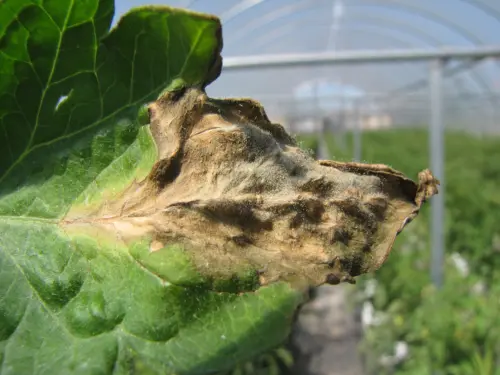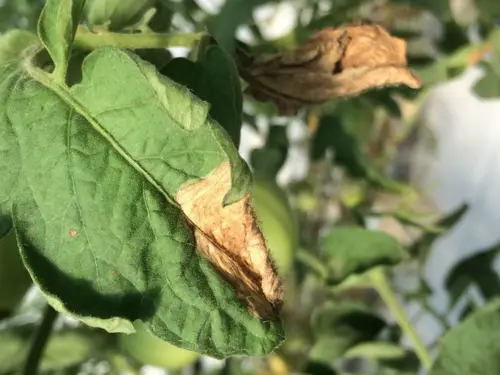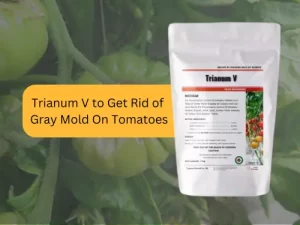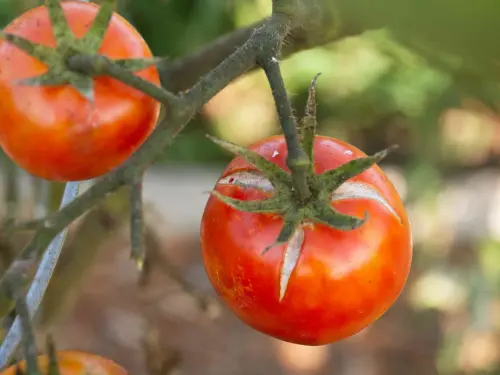Tomato growers across the world face the battle of the gray mold on tomatoes, the damaging fungal disease by Botrytis cinerea. This terrible fungus is adaptable in nature and resistant to changing environmental factors that makes them difficult to control and manage hence remain a great threat to tomato crops production.

Its strenuousness and unpredictable in many ways regarding its infection mechanisms contribute to the serious potential economic damage in the agricultural sector.
Meanwhile, In microbiology, the Trianum-V, organic fungicide to treat gray mold that prevents gray mold disease, from the beneficial fungus Trichoderma harzianum, is one of the innovative tomato leaf mold treatments. Promoting the eco-friendly use of the biological control where T. harzianum works as antagonist of B. cinerea application is an efficient strategy to protect tomatoes from gray mold attack.
With the help of environmentally friendly farming methods and superior quality products, grey mold is controlled by tomato producers, who can also guarantee a year’s worth of harvest. Know the way to how to get rid of white fungus on tomato plants in the blog below.
The cubicin A impiety Botrytis cinerea, Grey mold on tomatoes employs the most intriguing tactic to take over the plants. It prefers to invade open wounds or air pockets, and the arsenal of toxins and enzymes makes it possible to break through the defense system of a plant. These components are secluded out of the plant walls which makes the fungus grow in the tissues. Interestingly, B. cinerea engages in a sophisticated molecular interplay with the plant to be immune system by the host and perfect the colonization. Such an extremely ambiguous mechanism of pathogenicity helps the fungus surpass tomato plants’ usual defenses, often producing the result of severe disease manifestations and possible crop loss.
Tomato grey mould symptoms are distinct as it occurs in different forms. Gray mold on plants commonly exhibits itself by developing flaccidness in tomato plants accompanied by brown/black spots on tomato stems and leaves. Infected fruits and plants lose their radiant color and form a fuzzy gray mold as the disease progresses. This paddy-like growth is a sign of fungal activity as the fungus produces immense amounts of spores and mycelium which being lightweight in nature drifts easily and makes the affected parts appear powdery.
Time control on the occurrence of gray mold on plants is a critical step in planning successful management actions. undefined

On the one hand, the diagnostic procedure involves observations of the characteristic symptoms (e.g., the appearance of black spots, tomato stems streaks in the tomato stems, wilting, or gray mold development). Thereafter, a microscopic analysis is conducted to characterize the distinct spores and mycelial formations of B. cinerea with findings pointing towards the presence of the fungus.
The overall diagnostic process in this area includes not only the accurate identification of the culprit but also gives a valuable mirror of the level of infection to the doctors. To make the most sound decisions of how to control the disease, growers and plant pathologists with this knowledge use cultural practices like plant spacing and rotation, resistance breeding and selective fungicide applications or biological control agents.
Recent research highlights organic fungicides’ potential to control B. cinerea in tomatoes. Eco-friendly options leverage beneficial microbes’ incompatibility with harmful pathogens. Trianum-V, using Trichoderma harnzianum, offers a thermotolerant solution against gray mold. This approach supports an environmentally friendly, efficient battle for growers.
Integrated pest management, including cultural practices and resistance breeding, enhances protection. Advanced biological products like Trianum-V help manage gray mold effectively. This comprehensive strategy ensures crop safety, environmental balance, and a secure food supply. Ultimately, it leads to a plentiful, healthy tomato harvest.
Trianum-V and T. harzianum the organic tomato fungicide to defense against the grey mould, so they play an important roles during the process of preventing and control the Botrytis cinerea on the tomatoes, thus allowing the organic and traditional agriculture to develop and achieve the comprehensive and sustainable development. These products extract the advantage of helpful fungi to opponents, therefore, the crops have healthier and higher output.

Trianum-V, a organic fungicide to treat gray mold, is obtained from the helpful fungus species Trichoderma harzianum. It is tailored for foliar implementation so as to treat gray mold and other fungal infections. Trianum-V enhances plant immunity through SAR and ISR, triggering plants’ own resistance. Upon application to foliage, it competes for space and nutrients, acting like a hybrid organism. It functions as a mycoparasite, producing enzymes that degrade pathogenic fungi’s cell walls. This increases phytoalexins, cell wall strengtheners, and antioxidants, boosting the plant’s defense.
Trianum-V’s new control technology offers benefits like preventing molds, rots, spots, mildews, and blights from starting or spreading. It boosts yield and enhances plant stress resilience through improved crop quality. Trianum-V is an easy-to-use, residue-free wettable powder, suitable for organic production. No waiting period is needed between harvest and application, maintaining organic standards. Optimal effectiveness is achieved when Trianum-V integrates into a predictive disease management system. Apply at 2-3 grams per liter of water, focusing on leaf undersides, before symptoms appear or upon infection detection.
Trichoderma harzianum in Trianum-V controls soil-borne and foliar pathogens as a biological agent. It also improves nutrient uptake, regulates soil structure, and stimulates robust root growth. This fungus produces secondary metabolites that antagonize pathogenic fungi, reducing their growth and reproduction. Against cell wall-breaking parasites, it eliminates pathogenic bacteria, activating the plant’s defense system and enhancing disease resistance.
Trichoderma harzianum applies to soil or as a foliar spray, with dosages ranging from 1.5 to 3 kg/acre. It acts as eco-friendly technology, enhancing soil growth without risk of resistance. Its use significantly boosts crop yield and quality by strengthening root systems and nutritional uptake. Integrating Trianum-V and Trichoderma harzianum into farming practices effectively controls tomato grey mold. This approach benefits plant health and promotes sustainable agriculture ecosystems.

Struggle with gray mold in tomatoes is the understanding of fungus Botrytis cinerea and promptly detecting an infection for an effective control. Trianum-V has a sustainable and environmentally friendly strategy in place by employing Trichoderma harzianum to vaccinate against gray molds.
Study how to get rid of gray mold on tomato plants for more healthy yields. The environmental factors are variably significant for the progress of Trianum-V, the best organic fungicide for tomatoes, because they promote sustainable development.
Cutworms in gardens are a major menace to all..
As a farmer,I inspect my fields daily to monitor..
It all started with a worried farmer named Mr...

Leave a Reply